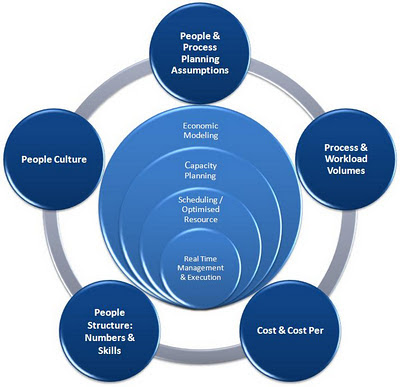- Improved customer experience by better schedule to forecast and adherence to schedule
- Zero-based budgeting, underpinned by planning
- Improved work/life balance of staff
- An enabler for process improvement
- Known implications of operational decisions through scenario planning
- Financial cost control
- Optimised digital to human contact journeys
- Outbound SMS/Email/Print smoothing and throttling
The accepted industry standard definition for a Workforce Management (WFM) process can be defined as:
“The art of having the right number of correctly trained and skilled staff, in the right place and at the right time, with the right supporting resources, to handle an accurately forecasted workload at service level and with quality”This definition is the foundation for any type of resource planning and operational management for any type of business regardless of its size, function, complexity or location.
A truly successful workforce planning process is a strong combination of detailed planning and review, supported by real time management control, review and communication – all wrapped in robust governance processes.
From a functional perspective, the WFM process incorporates all the key elements of (see above diagram):
- Strategic and Economic Workforce Planning - requirement and costs to deliver profit and customer service targets, predictions of “cost per process” metrics. Informs good business decisions and yields important data such as hiring ease or difficulty, time to hire, time to productivity, attrition rates and so on, which can help identify risks and contingency actions.
- Capacity Planning (largely medium term planning – a 12+ month rolling view) - FTE and desk requirements, forecasts for FTE surplus/deficit, indicative service level delivery forecasts, and recruitment needs and/or FTE movement/overtime forecasts.
- Scheduling (short term planning – up to 3 months ahead) - Scheduling of front line staff to match customer demand across the opening hours of an operation, and refined intra-day Service level predictions.
- Operational Delivery & Real Time Management - Monitors service delivery and schedule adherence in real time, identifies service hotspots and remedial actions required, provides detailed analysis/insight of service performance to feed future planning processes and to inform performance management within an operation , inputs on the day changes to schedules and manages impacts to service.




